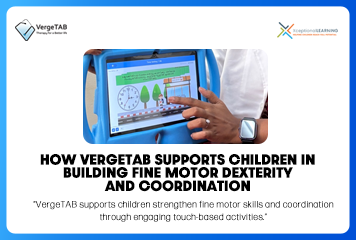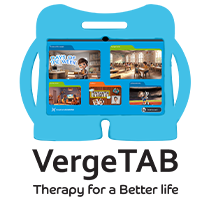How VergeTAB Supports Children in Building Fine Motor Dexterity and Coordination
14 Oct 2025

Imagine your child reaching for a zipper, fingers fumbling as they try to pull it up. This seemingly simple task is actually a complex orchestration of fine motor skills— the small, precise movements that allow us to button shirts, hold pencils, tie shoelaces, or tap and swipe on a screen. For many children, especially those with developmental challenges, mastering these everyday actions takes time, patience, and targeted support. Rehabilitation Therapy plays a huge role in helping them develop these skills, but digital tools can aid and quicken the process.
Understanding Fine Motor Skills
Fine motor skills are the small, controlled movements made with the hands, fingers, and wrists. They include:
- Grasping: Holding objects like a bead, crayon, or spoon
- Manipulation: Twisting, turning, pinching, and moving small items
- In-hand coordination: Moving an object within one hand (e.g., transferring a coin from palm to fingertips)
- Bilateral coordination: Using both hands together (one stabilizes while the other works)
- Eye–hand coordination: Coordinating what the eyes see with how the hands move (e.g., tracing or reaching for a target)
These skills develop through play and practice from infancy through early school years and continue to be refined after that.
Why do Fine Motor Skills Matter?
Strong fine motor skills are essential for everyday independence and school success. Children with weak fine motor skills may struggle with dressing (buttons, zippers, shoelaces), eating with utensils, handwriting, drawing, using scissors, managing classroom tools (glue sticks, rulers), or navigating touchscreens (taps, swipes, drag-and-drop). Beyond practical tasks, developing fine motor skills also boosts confidence, self-care, and participation in classroom and play activities.
How VergeTAB + XceptionalLEARNING Helps
VergeTAB is a blank, controlled tablet that runs only on the XceptionalLEARNING platform, creating a safe, focused space for practice. Its benefits include:
- Therapist-guided content: Activities target specific skills and keep practice focused.
- Adjustable difficulty: Tasks can be tailored to each child’s level.
- Progress tracking: Accuracy, speed, and repetitions are logged for monitoring improvement.
- Interactive practice: Touchscreen gestures like tapping, dragging, and tracing a map to real-world skills.
- Engaging and safe: Game-like activities motivate children without ads or unrelated apps.
Tablet Practice
Many parents wonder how practicing on a tablet can help with real tasks like buttoning or handwriting. If activities are carefully chosen and paired with real-world practice, it transfers into visible results:
- Touchscreen activities train the same hand-eye coordination and precision needed for everyday tasks.
- Tracing shapes digitally improves visual-motor control used in handwriting.
- Drag-and-drop and tapping refine finger isolation and timing.
- Repetitive, graded practice strengthens neural pathways and muscle control.
Important: Tablet practice should complement, not replace, real-world practice like grasping objects, using scissors, or threading beads. Combining digital and hands-on tasks gives the best results.
Practical VergeTAB activities for building fine motor skills
Below are concrete, easy-to-follow activities you can use on VergeTAB (via the XceptionalLEARNING platform) and how to pair them with physical tasks.
1. Tracing shapes and lines
What it trains: Pencil control, eye–hand coordination, wrist stability.
Tablet task: Trace increasingly complex lines and shapes (straight lines → curves → letters). The platform can show a ghost line and provide graded assistance.
Real-world pairing: Paper tracing with a crayon or marker; air-drawing letters while saying the letter name.
2. Dot-to-dot and connect-the-dots
What it trains: Precision tapping, sequence planning.
Tablet task: Tap numbered dots to reveal a picture. Timing and accuracy are measured.
Real-world pairing: Paper dot-to-dots, bead-stringing in number order, or sticker sequencing.
3. Drag-and-drop sorting
What it trains: Pincer grasp, controlled release, bilateral coordination.
Tablet task: Drag items into categories (colours, shapes, sizes). Difficulty can increase with smaller targets and time limits.
Real-world pairing: Sorting coins, buttons, or coloured blocks into containers.
4. Pinch and zoom refinement
What it trains: Thumb–index pinch strength and control (useful for scooping and pinching objects).
Tablet task: Pinch to zoom puzzles or to pick up tiny virtual objects.
Real-world pairing: Picking up small items like beads, using tweezers, or practicing clothespin transfers.
5. Virtual finger mazes
What it trains: Steady fingertip pressure, wrist control, and visual tracking.
Tablet task: Move a virtual object slowly through a maze without touching the edges. The platform can detect and log touches.
Real-world pairing: Trace a finger through a raised-line maze on cardboard or follow a path with a stylus on paper.
6. Fast-finger games (timed tapping)
What it trains: Reaction time, controlled tapping, sequencing.
Tablet task: Tap targets that appear quickly in different places. Adjust speed and size.
Real-world pairing: Clap patterns, tapping rhythms on a table, or flashcard quick picks.
7. In-hand manipulation drills (virtual)
What it trains: Moving objects within one hand (palm → fingertips).
Tablet task: Rotate and position an object using taps and gestures that require switching fingers.
Real-world pairing: Manipulate coins, move small erasers from palm to fingertips, or practice flipping a pencil end-to-end.
8. Bilateral coordination activities
What it trains: Using both hands together (stabilize + manipulate).
Tablet task: One side of the screen requires holding a virtual object steady while the other side performs tasks.
Real-world pairing: Holding paper with one hand while cutting with scissors; stabilizing a jar while unscrewing a lid.
9. Handwriting warm-ups
What it trains: Pre-writing strokes & letter formation.
Tablet task: Animated warm-ups (circles, lines, waves) that encourage fluid motions.
Real-world pairing: Warm-up with playdough rolling, finger painting strokes, or chalk drawing.
10. Simulated daily tasks
What it trains: Transferable skills for ADLs (activities of daily living).
Tablet task: Simulated dressing board or button task where the child must sequence steps to dress a character.
Real-world pairing: Practice buttoning a shirt or zipping jackets on a doll or self.
Structuring a Practice Session
- Total session: 15–20 minutes
- Frequency: Daily or 4–5 sessions per week for steady progress
Short, focused, fun sessions work best. Here’s an easy structure:
- Set a clear goal (30 seconds)
- Example: “Trace circles for 2 minutes.”
- Warm-up (2–3 minutes)
- Example: tracing large shapes or finger mazes.
- Targeted practice (6–10 minutes)
- Focus on 1–2 activities just above the child’s level.
- Real-world transfer (5–7 minutes)
- Pair tablet practice with a physical task.
- Cool-down and praise (1–2 minutes)
- Celebrate effort and set a simple goal for next time.
Integrating VergeTAB into IEP goals
VergeTAB pairs smoothly with therapy plans and school goals:
- The therapist assigns activities that match IEP goals (e.g., improve pencil grasp, increase handwriting legibility).
- Data-driven decisions: Use the platform’s progress data to adjust difficulty or change strategies.
- Home-school connection: Therapists can share activity lists or suggested real-world practice with parents and teachers so everyone uses the same approach.
- Goal examples:
- Increase accuracy when tracing lines from 50% → 80% in 8 weeks.
- Improve two-handed cutting accuracy by practicing bilateral coordination tasks twice weekly.
Using VergeTAB for measurable practice helps make therapy time efficient and consistent.
Safety, ergonomics, and screen-time guidelines
Ergonomics
- Table height: Child should sit with feet flat (or supported) and elbows roughly at table height.
- Tablet angle: Slight tilt (20–30°) reduces neck strain.
- Grip: Encourage a relaxed fingertip touch, not a death grip.
- Breaks: Use the 5–10 minute break rule for every 20–30 minutes of focused screen use.
Screen-time guidance
- Keep practice sessions short (10–20 minutes). Multiple short sessions are better than one long one.
- Prioritize active, purpose-driven screen use (therapeutic activities) over passive watching.
- Balance tablet time with hands-on play: playdough, blocks, arts, puzzles, and outdoor play.
Device Care
- Clean the touchscreen regularly with child-safe wipes.
- Use a durable case to avoid breakage during play.
Measuring Progress
VergeTAB + XceptionalLEARNING make progress easy to track, but parents can also monitor at home:
Observable improvements:
- Better control in handwriting/drawing
- Faster buttoning/zipping
- Increased independence in self-care
- Improved scissors and utensil use
Parent-friendly tracking:
- Keep a weekly log (activity, difficulty, repetitions, notes)
- Take monthly handwriting photos for comparison
- Review platform reports for accuracy, speed, and levels achieved
Reassess if: No improvement after 8–10 weeks of consistent practice — adjust activities, difficulty, or increase hands-on practice.
Build Practice into Daily Routines
- Morning: Finger stretches while brushing teeth + 5-min VergeTAB warm-up
- Snack time: Open containers and transfer small snacks to improve grip
- Art time: After tablet session, 10 min of drawing or bead stringing
- Bedtime: Gentle hand play (playdough, finger tracing) as a calming practice
Small, repeated opportunities help children develop skills naturally throughout the day.
Conclusion — small steps, steady gains
Building fine motor dexterity and coordination takes small, consistent practice over time. VergeTAB, paired with the XceptionalLEARNING platform, provides a focused, safe, and measurable environment for children to develop essential skills. When tablet-based practice is combined with real-world activities and positive encouragement, children gain independence, confidence, and school readiness.
Start small: set a tiny goal (e.g., trace circles for two minutes), follow it with a real-world task (like crayon tracing), and celebrate every effort. Over weeks, these small wins become everyday skills — tying shoes, writing, and self-feeding.
For parents, teachers, or therapists, VergeTAB is the Interactive Learning Device for Children that supports the best therapy services with a tablet and acts as a Digital Therapy Activity Device. Focus on consistency, keep sessions short and playful, and use the platform’s data to guide progress. Contact us today to learn how VergeTAB can help your child flourish.Â


